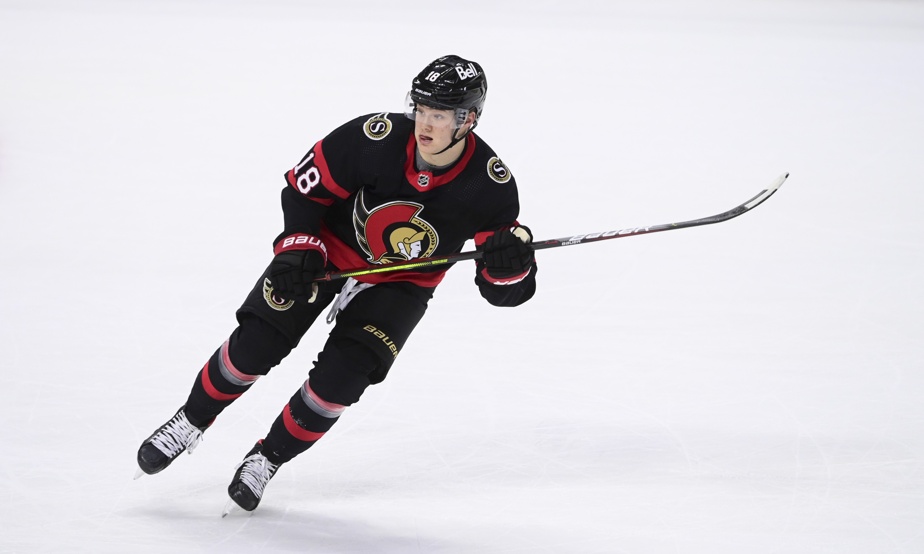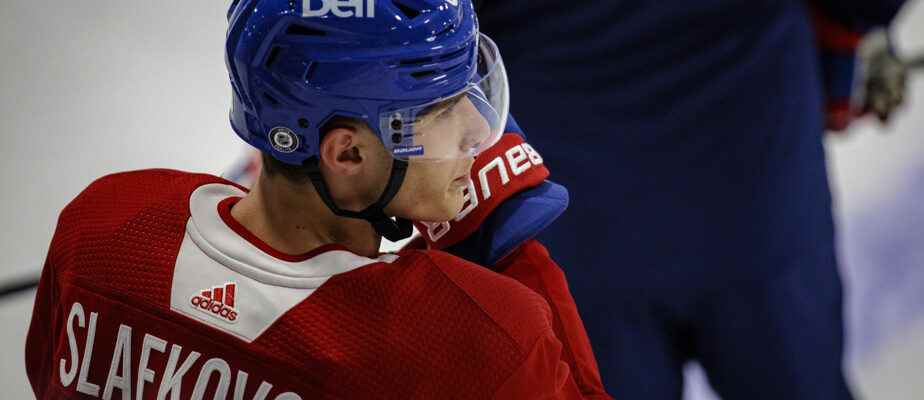(Arlington, Va.) Few 18-year-old players make it to the NHL immediately after being drafted. Every year, two or three attackers arrive there, sometimes a defender.
Posted at 6:24 p.m.
Until 2021, the athlete drafted in the very first place systematically joined the team that had selected him. Owen Power of the Buffalo Sabres, however, broke with tradition last season by returning to the NCAA.
It is therefore not completely far-fetched to wonder whether Juraj Slafkovsky, first choice of the most recent draft, will begin the next season in the uniform of the Montreal Canadiens or that of the Laval Rocket, in the American League.
The young man himself is cautious about this. On Tuesday, he met some journalists at the Washington Capitals training complex in Arlington, a suburb of the American capital, as part of the NHL Rookie Showcase, an event organized jointly by the Players Association and by the Upper Deck hockey card maker.
The Slovak has, unsurprisingly, promised that he will “do everything to play in the NHL” as soon as possible. “But of course I’m going to do what the Canadiens believe will be best for me,” he quickly added.
To a journalist who asked him if he had already settled in his adopted city, the colossus indicated that he did not know “yet where” he was going to play.
The management of the club as well as the coaching staff have not yet established an action plan with him, he assures.
“We haven’t talked about it yet. The camp [des recrues] starts next week [la réponse] will come from there. We’ll see if I’m ready. »
Few points of comparison
Very smart one who can predict with certainty, at this point, the immediate future of Slafkovsky. Because recent history makes it difficult to find an obvious point of comparison.
From 2012 to 2021, i.e. over the last 10 seasons, 31 players have established themselves in the NHL in the year of their draft, thus playing the majority of their team’s games. Twenty-five of those were attackers.
But only seven were European and had never played on a regular basis on North American rinks before: Aleksander Barkov, Elias Lindholm and Valeri Nichushkin (2013), Patrik Laine (2016), Jesperi Kotkaniemi (2018), Kaapo Kakko ( 2019) as well as Tim Stützle (2020). We did not include David Pastrnak (2014) in our compilation since he started his draft season in the American League.

PHOTO SEAN KILPATRICK, THE CANADIAN PRESS ARCHIVES
Tim Stützle, Ottawa Senators
All except Nichushkin had played 41 to 85 games in European professional leagues before moving to North America. And they had been regular offensive contributors.
Having only played 31 games last season in Liiga, the main Finnish league, and having accumulated only 10 points there, Slafkovsky presents a decidedly different profile from the group described above.
In his entire life, he has only played a handful of international matches on North American rinks, which are smaller than European ice. This small sample already makes him say that he must adjust his “reaction speed”.
Three other players met at the Rookie Showcase confirmed that they had to make serious changes to their game while crossing the Atlantic. German Lukas Reichel, of the Chicago Blackhawks, estimates that he needed “10 to 15 games” before starting to feel comfortable in the American League. Swedish Samuel Fagemo said he struggled for “15 to 20 games” in the Los Angeles Kings school club before finding his bearings.
The two attackers, smaller than Slafkovsky it is true, explained that it is along the boards that the difference is most obvious. “The game is faster and you have to protect the puck better,” summarized Fagemo. “There are some for whom it clicks right away, but it’s really not the case for everyone,” added Reichel.
“It’s really not a myth,” insisted Czech goalkeeper Lukas Dostal about the necessary adaptation between the two worlds.
“In Europe, attackers can get around defenders, which happens very rarely here, continued the hope of the Anaheim Ducks. They must therefore slow down the game and wait for the second wave in support. The whole rhythm is different. »
Impact
Adaptation, however, does not mean failure. Reichel found a way to amass 10 points in his first 10 games with the Rockford IceHogs last season, his first in the United States.
To a lesser extent, the seven Europeans in the group described above also had good times early on. After 20 games, they had collected from 7 (Lindholm) to 18 (Laine) points. None, however, were able to sustain that pace for their entire first season.
Inevitably, when it comes to player development, the word patience comes up in conversation. Many were still those who praised it on Tuesday. Defenseman Simon Edvinsson, drafted by the Detroit Red Wings in 2021, said he was happy to have spent the last season in his native Sweden.
Buffalo Sabers defenseman Owen Power and Seattle Kraken forward Matty Beniers agreed. Selected first and second respectively in 2021, they both returned to the University of Michigan rather than joining their respective clubs a year ago. It was the first time in 25 years that the two top prospects in the draft postponed their start to their careers.
“It helped me as a player and as a person,” Power said. In addition, underlined Beniers, “we know how tough the NHL is, we want to perform as soon as we arrive”.
Obviously, Slafkovsky does not have the leisure to choose his own destiny as Power and Beniers did. However, we suspect that he too will want to have an immediate impact on his new team.
It only remains to determine if it will be the Canadian or the Rocket.

